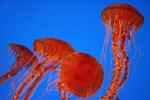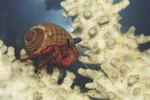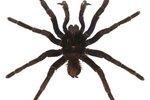Deep water spider crabs include at least four known species from two genera: the Japanese spider crab (Macrocheira kaempferi) and three Pleistacantha species (P. ori, P. moseleyi and P. pungens). The Japanese species is largest -- the largest known arthropod -- with a leg span up to 13 feet. With an adult weight of up to 40 pounds, it's outdone only by a few champion American lobsters.
Spiny Business
The bottom of the ocean is a busy place, populated by sucking tentacles and hungry mouths. If you're a spider crab, neighbors try to open your carapace, break off your legs and pluck out your eyes on a daily basis. Deep water spider crabs use their spiny carapaces to conceal themselves within their rocky, crusty surroundings. They protect their eyes by pulling them behind bony spines. Their hooked feet allow them to scale rocky peaks.
A Sticky Situation
These crabs don't have natural camouflage -- they're actually bright orange. This doesn't matter in the dark of the deep, but when they move into shallower waters, they become targets. They've behaviorally adapted to be slightly less conspicuous: they pull sponges and other non-mobile animals off their natural substrate and stick them to their own bodies. Thus accessorized, they blend into shallow environments much better.
Burning Mountains, Freezing Valleys
The ocean floor is an uncharted wild land of seamounts spewing superheated gas punctuated by abyssal valleys so deep the water pressure would instantly smash any human unlucky enough to find herself there. The crabs' bodies allow travel between extreme environments by distribution of mass. While their legs grow throughout their lives, their bodies stop growing around the time they reach sexual maturity, creating wide but very thin bodies encased in hardy exoskeletons. These exoskeletons keep pressure spread out so they can travel in and out of the deepest trenches without sustaining fatal damage.
Varied Menu, Safe Haven
Food is scarce on the ocean floor, over a quarter mile from the nearest photosynthesis to create plant havens. The crabs may know this, because they've adapted to happily munch virtually anything that's swimming, crawling or falling, alive or dead. But what goes around comes around, and crab eggs are a delicious delicacy for many of their fellow denizens. So the spider crabs come up into the shallows to breed. They still lay their eggs among many potential predators, but there are more food choices for predators in shallow waters. After hatching, the free-swimming larvae join the zooplankton before finally settling back down on the ocean floor at a more formidable size.
A Fierce Predator
Human culinary interest in deep sea spider crabs is growing, and while these animals are often marketed as "sustainable," the way they're usually harvested is not. Seamounts and vents are hunted by trawlers -- enormous ocean-going factories that pull up all life plus portions of the actual ocean floor and dump out the unwanted dead and dying "by-catch." This stripping disrupts and removes the ecological substrate that allows life to flourish in these hostile, incredibly slow-growing environments. Human predation is one threat the crabs have no adaptations to survive.
References
- Encyclopedia of Life: Macrocheira kaempferi - Japanese Spider Crab
- Tennessee Aquarium: Giant Spider Crab - Macrocheira kaempferi
- The Raffles Bulletin of Zoology: Pleistacantha ori, a New Species of Deep Water Spider Crab (Crustacea: Decapoda: Brachyura: Majidae) From the Western Indian Ocean
- Birmingham Science Museum: Japanese Giant Spider Crab
- The University of Tasmania, Australia: Zooplankton - Crab Larvae
- The University of Tasmania, Australia: Zooplankton - Crab Larvae
Resources
Writer Bio
Angela Libal began writing professionally in 2005. She has published several books, specializing in zoology and animal husbandry. Libal holds a degree in behavioral science: animal science from Moorpark College, a Bachelor of Arts from Sarah Lawrence College and is a graduate student in cryptozoology.





